Needing a Space to Commemorate All Wisconsin's Veterans
On June 6, 1993 after more than 80 years at its location in the Wisconsin State Capitol, the G.A.R. Memorial Hall evolved into what is now the Wisconsin Veterans Museum and opened at a new location at the top of State Street on the Capitol Square. The move came after years of planning and packing, which included the mammoth task of retrofitting the Ben Franklin store that occupied 30 West Mifflin Street into an adequate space for a then-state-of-the-art museum.
While in the Capitol, the space was known primarily as the “Civil War Museum.” This moniker was based off its founding by Civil War veterans in 1901 and the fact that the 2,640 square feet of exhibition space primarily focused on the Civil War artifacts in the collection. Although there is a statutory mandate to also commemorate Wisconsin’s role in “any subsequent war,” and Wisconsin’s veterans stories provided plenty of opportunity, the G.A.R. Memorial Hall Museum lacked the room to expand.

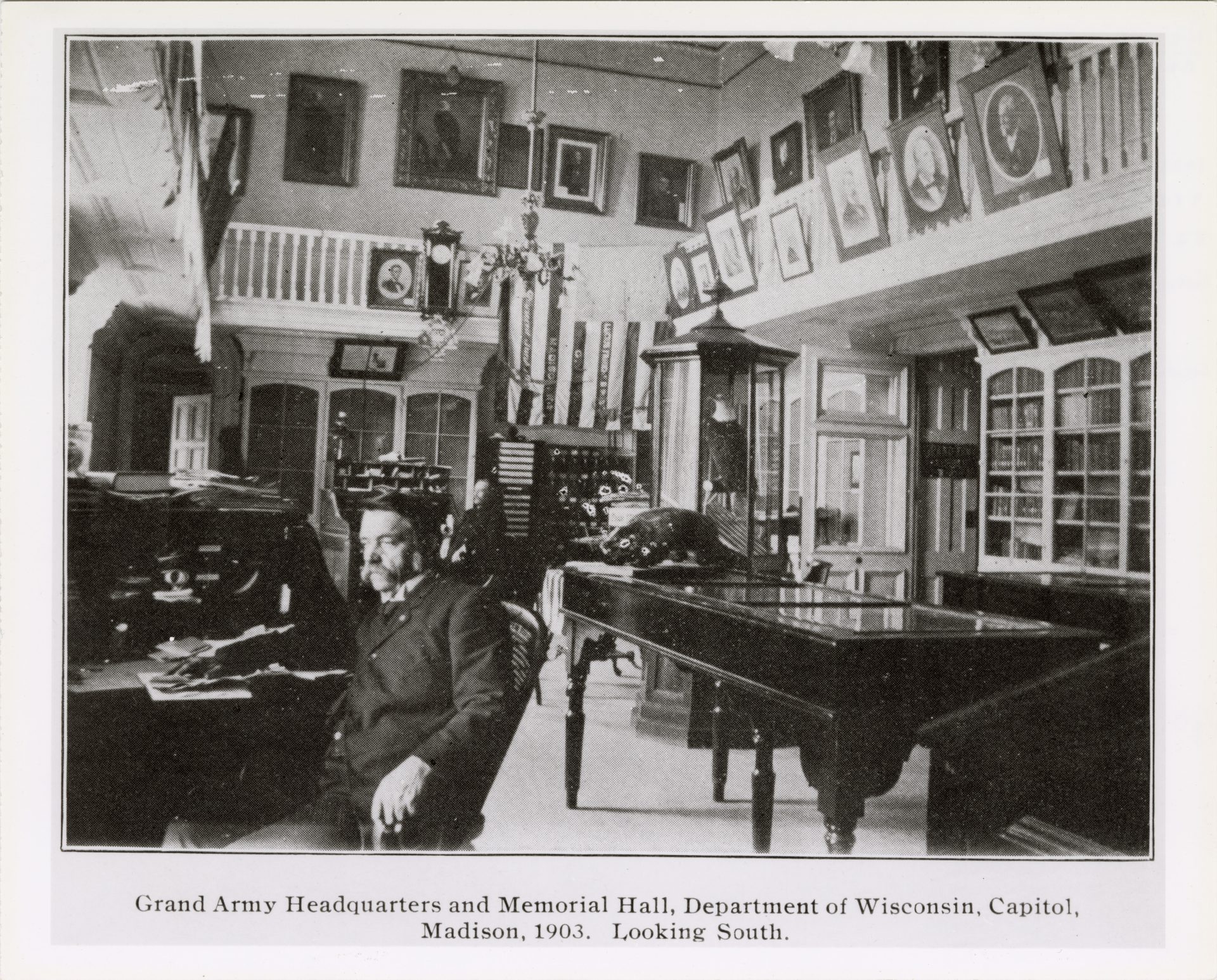
A Plan for a Modern Museum
Improvement initiatives focused on bringing the museum up to professional standards – including the hiring of the first professional curator – further demonstrated that the space was inadequate at a professional museum level. More important, the space in the Capitol impeded its ability to truly honor the World Wars generations, much less Korea and Vietnam, and those generations that follow. Ultimately, it was the limitations of space that dictated the necessity for either a significant redevelopment and modernization or a new location.
In 1979 a modernization plan was rejected by the state legislature. Undeterred, the Wisconsin veteran community championed the development for a new museum space. In 1985 WWII veteran and Secretary of the Wisconsin Department of Veterans Affairs John Maurer secured a political agreement that allowed the museum to search for space outside the Capitol to develop exhibits incorporating the contributions of Wisconsin’s veterans in the 20th century. In 1989, Governor Tommy Thompson approved the acquisition of a new leased space across the street from the Capitol with the intent to purchase the location at some point in the
future. For the first time in its history, the G.A.R. Memorial Hall Museum had an opportunity to create a more professional and engaging visitor experience with over 10,000 square feet of exhibition space.
The design team laid out an exhibit plan in a timeline approach from the Civil War up to then-current day. Generally, the timeline of events is a good approach as it meets the audience where they’re at in their understanding of history. The issue with that approach is that what defines present day is fluid. Unless you build in flexibility and room to expand, space constraints will catch up very quickly as time always moves forward.
Forward
This truth was evident even from the date the G.A.R. museum closed from November 10, 1989 to when the Wisconsin Veterans Museum opened on June 6, 1993. In those 3.5 years at least 95 Wisconsinites died while serving. Our world changed significantly: the Berlin Wall fell, the Cold War was declared ended, the Soviet Union dissolved, Operations Just Cause (Panama), Desert Shield, and Desert Storm occurred, no-fly zones over Iraq were established, and the first World Trade Center bombing occurred. Fortunately, there was time in the design phase to adjust for inclusion of those significant stories but the space available meant that future inclusion of stories from anything beyond the Desert Storm era would mean taking away from some other era’s stories.
As we know, history is always on-going and rarely cleanly stops like an end to a chapter in a book.
Perhaps it’s even tragic coincidence that the day before the grand opening at 30 W Mifflin, there was an attack on UN forces in Somalia that ultimately led to the fateful events in Mogadishu that October which claimed the life of another Wisconsinite. Within those initial years, the timeline continued to grow and Wisconsin Was There: Bosnia, Kosovo, the Third Taiwan Straits Crisis, Operations Desert Strike and Desert Fox in Iraq, and those are just in the first seven years after opening that rounded out the decade and closed the millennium.
Nonetheless, the opening of the Wisconsin Veterans Museum in 1993 was a dramatic milestone in the institution’s history not only in terms of space, but also in terms of community engagement through the development of the new exhibits. Within the walls of the repurposed Ben Franklin store, large, beautiful murals were painted by nationally renowned military history artist Keith Rocco. Veterans, their families, and military history enthusiasts alike contributed material for the dioramas, and in some cases even posed as models for the mannequins. The Wisconsin National Guard was instrumental with the transport and installation of the oversized aircraft and vehicles that have become focal points of the displays.
And with the grand opening itself, the engagement of the community was as evident as ever. The speakers at the
ceremony included Secretary of the U.S. Department of Veterans Affairs Jesse Brown, Governor Tommy Thompson, Secretary of the Wisconsin Department of Veterans Affairs Ray Boland, and others. The Wisconsin National Guard’s 132nd Army Band played as helicopters from the Guard performed a flyover. Active -duty members of the 101st Airborne Division Parachute Demonstration Team performed a jump landing in the street in front of the new museum. Civil War reenactors paid tribute to the original generation of Wisconsin veterans that started the museum nearly 90 years before. Over 7,700 people attended the opening festivities that day.
In his remarks, Governor Tommy Thompson summarized the significance of the museum and its symbolic meaning to our state’s veterans, their families, and all its citizens, “It’s absolutely essential to honor those who served… the museum is the story of Wisconsin veterans, of citizens called to arms… this museum is for you.”
Today the museum staff faces similar challenges as leaders did in the 1980s. How do we adequately tell the stories and honor our veterans from all eras of service as time passes? This is the question we consider daily as we strive to honor, commemorate, and affirm the role of all Wisconsin veterans in our nation’s military history: past, present, and future.
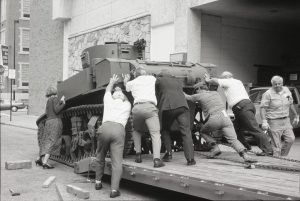
Staff and volunteers improvised the unloading of the Stuart tank upon its arrival.
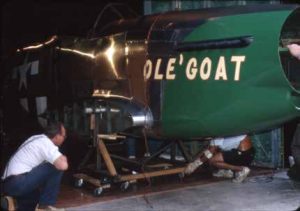
The full-scale P-51 Mustang model was based off the plane “Ole’ Goat” flown by WWII Double Ace George “Pop” Doersch of Seymour, Wisconsin.
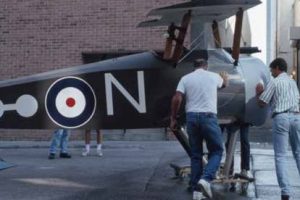
The full-scale bi-plane model was based off the plane flown by WWI Ace Rodney Williams of Delafield, Wisconsin
Opening
Nonetheless, the opening of the Wisconsin Veterans Museum in 1993 was a dramatic milestone in the institution’s history not only in terms of space, but also in terms of community engagement through the development of the new exhibits. Within the walls of the repurposed Ben Franklin store, large, beautiful murals were painted by nationally renowned military history artist Keith Rocco. Veterans, their families, and military history enthusiasts alike contributed material for the dioramas, and in some cases even posed as models for the mannequins. The Wisconsin National Guard was instrumental with the transport and installation of the oversized aircraft and vehicles that have become focal points of the displays.
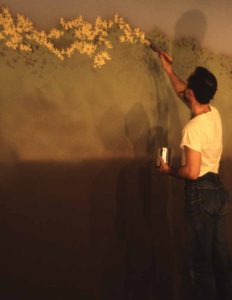
Nationally renowned military history artist Keith Rocco painted the diorama murals in the galleries.
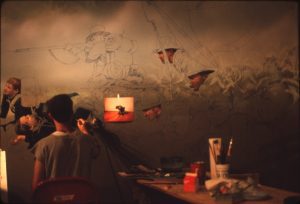
Nationally renowned military history artist Keith Rocco painted the diorama murals in the galleries.
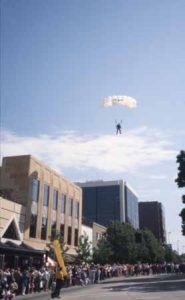
A member of the 101st Airborne Division Parachute Demonstration Team comes in for a landing on Mifflin Street, right in front of the museum.
Engaging Veterans of the Modern Eras
And with the grand opening itself, the engagement of the community was as evident as ever. The speakers at the ceremony included Secretary of the U.S. Department of Veterans Affairs Jesse Brown, Governor Tommy Thompson, Secretary of the Wisconsin Department of Veterans Affairs Ray Boland, and others. The Wisconsin National Guard’s 132nd Army Band played as helicopters from the Guard performed a flyover. Active -duty members of the 101st Airborne Division Parachute Demonstration Team performed a jump landing in the street in front of the new museum. Civil War reenactors paid tribute to the original generation of Wisconsin veterans that started the museum nearly 90 years before. Over 7,700 people attended the opening festivities that day.
In his remarks, Governor Tommy Thompson summarized the significance of the museum and its symbolic meaning to our state’s veterans, their families, and all its citizens, “It’s absolutely essential to honor those who served… the museum is the story of Wisconsin veterans, of citizens called to arms… this museum is for you.”
Today the museum staff faces similar challenges as leaders did in the 1980s. How do we adequately tell the stories and honor our veterans from all eras of service as time passes? This is the question we consider daily as we strive to honor, commemorate, and affirm the role of all Wisconsin veterans in our nation’s military history: past, present, and future.
Learn more about the plan for a new museum space.

